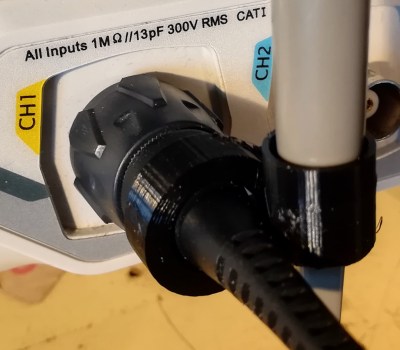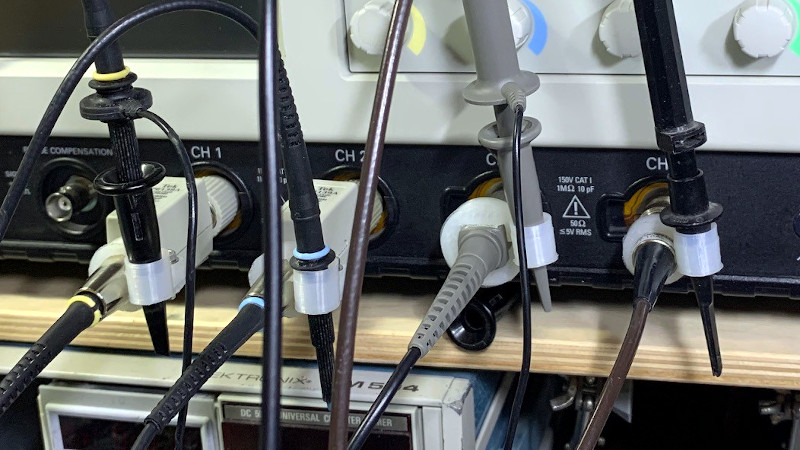Sometimes the projects we write up for Hackaday require their creators to produce pages of technical explanation, while others need only rely on the elegance of the hack itself. The Scope Probe Caddy from [Tonyo] has probably one of the shortest write-ups we’ve linked to from a Hackaday piece, because its utility is self-evident just by looking at it.

It’s likely that everyone who has owned an oscilloscope will have encountered this problem: that multiple ‘scope probes soon manifest themselves into a tangled mess, an unruly octopus which threatens to overwhelm your bench. The probe organizer is an extremely simple solution tot his problem, a 3D printed clip which fits over the probe connector and into which the probe itself can also slot.
The clip comes as an OpenSCAD file, which starts with a range of size definitions for different types of probe connector. The Rigol we have here isn’t among them, but a very quick measurement with the calipers allowed us to enter the size of a Rigol probe connector at 11.5 mm. It’s not often we make something we’re writing up as we’re writing it, but in this case a quick bit of 3D printing and we too have tidy probe storage. With the addition of a cable tie or a small nut and bolt it’s assembled, and now helps make a Hackaday bench a little clearer.
Once you’ve printed this organizer, you might want to turn your attention to the probe itself.

















Where’s the Like button?
B^)
At this moment my tangle of scope probes are in the way of the 3d printer. This is a project that’s going to happen.
I expect openscad hate to follow (there’s some kind of Hackaday Godwin’s law corollary for openscad), but I’m delighted the files are available in openscad format.
Hate for OpenSCAD here? Really? I’ve never seen much – some folks might prefer other packages but the folks here generally at least seem to appreciate somebody else’s well written parametric OpenSCAD model, even if they really hate working in it themselves…
For myself I would prefer it to be OpenSCAD for simple models and something like FreeCad for more complex options – there comes a point with OpenSCAD that becomes hard to alter or expand the existing model to do what you need.
I definitely can appreciate others models, but I can’t think of any reason I’d ever use it myself.
The big problem is it’s not really CAD. CAD means computer aided design. OpenSCAD doesn’t seem to aid you in your design, as a tool with constraints and interactivity might. It’s a description language for a design you already have.
More of a “Computer Alternative to Drafting” as I see it.
Since we’re designing things with OpenSCAD, it’s computer aided design. The drafting is just there to help the design process. The operations you do with other CAD programs by using the GUI are also possible with OpenSCAD, but they are written out programmatically and parametric. It’s like the reveal codes option in Wordperfect (if you’re old enough ;).
The advantage of this approach is that you can easily tweak those operations the get to the desired output, although “easily” depends on the way you code in OpenSCAD.
I love OpenSCAD, it’s my go-to tool for modelling functional parts. But I concur with what was already said here a few days ago, it’s “for programmers” about as much as Perl or COBOL or PHP, but without their flexibility.
It is also unlike most programming languages, in that it is not taught/codified to be particularly consistent so its often less readable than real code, where once you learn the language there is a real commonality in grammar that makes less well commented code still feel readable.
Not to say programing languages can’t be just as bad (or much much worse even), but there tends to be a style guide that is sort of baked into how you generally learn the language, and for most languages those style guides are similar to other languages and fairly universal it would seem.
Enjoy replacing broken BNC connector in 2-4y.
Doubtful. The weight of the probe in the clip is less than that of a dangling cable with probe.
If they just drop in, it should be fine, but yeah, gonna be a stress fuzz test on those sockets if any insertion force is required.
Don’t get me wrong, it’s good idea poorly executed. Look at all that space between shelve and scope, it’s waiting for adapter, and it won’t block buttons on scope, when not all channels are in use.
I guess one could consider something like those snap-in self adhesive cable clips, though durabality for frequent insertion would also be in question. Might not be too bad with reasonable quality ones, that advertise 3M mounting adhesive or something. One could put those on the scope body either side, or one each side, a couple underneath a couple on top for larger numbers of probes.
I thought this would be about a “super simple scope”.
It reminds me of an article in CQ about 1958. John W Campbell wrote about a simple scope, no amplifiers. But by reducing the voltage, you got better sensitivity. So no need for amokifiers, which of course are hard to make flat and broadband. Of course you don’t get much deflection. It was based on work at Bell Labs. It was another fifteen or so years before there were “broadband” scope projects.
It wouldn’t help my setup, it doesn’t address the big loop of dangling cable that would itself always be in the way. I’d rather just roll it up and tuck it away when I didn’t need it for a bit.
Now we just have to do something about those crappy Rigol probes. They drive me nuts. I have two decent HP probes that cost more than the scope did, which mainly serve to highlight just how frustrating those godforsaken Rigol instruments of torture are.
Paul, what’s your gripe with the Rigol probes? (I don’t think I’ve used any other kind)
“tot his problem” :)
Mehhh too complicated. I just put a little velcro on the probe and put the hook strip someplace convenient and out of the way. Took all of 30 seconds.
Hmm, not really userfriendly: The unused probes of Ch3 and 4 block access to the controls.
This headline is what happens when you hire the alliterate!
;’)
This was probably written six months ago, and it took all that time to create the headline.
Either that, or they have someone who can do alliteration without any effort. I’ve noticed it’s fairly common here.
OK, I was about to print a set of these, then I saw this nifty drawer system for scope probes on Printables: https://www.printables.com/model/180580-oscilliscope-probe-organizer
Those little drawers would be great but they’re designed in fusion360.